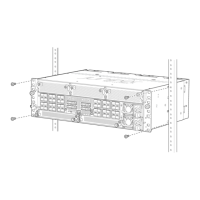
Do you have a question about the Juniper ACX7348 and is the answer not in the manual?
| Brand | Juniper |
|---|---|
| Model | ACX7348 |
| Category | Network Router |
| Language | English |
Guides through the simplest steps for common installation to get the router in a rack and connect it to power.
Details how to connect the ACX7348 router to AC power, covering grounding and power cord connections.
An overview of the ACX7348 cloud metro router, its hardware components, and the Junos OS Evolved software.
Details the ACX7348 as a multiservice platform for metro applications, highlighting its form factor, throughput, and capabilities.
Highlights the advantages of the ACX7348, including its platform, infrastructure, ease of deployment, and next-generation capabilities.
Explains Field-Replaceable Units (FRUs) for the ACX7348, categorizing them as hot-insertable/removable or hot-pluggable.
Describes the redundant hardware components of ACX7348 routers, focusing on Routing Engines and Power Supply Modules (PSMs).
Details the Junos OS Evolved operating system for the ACX7348, emphasizing its features and benefits for network management.
Describes the router chassis as a sheet metal structure housing all components, including FPC, REs, PSMs, and fan trays.
Provides detailed physical specifications for the ACX7348 router chassis and its various components, including dimensions and weight.
Explains how the cooling system and airflow work together to maintain optimal operating temperatures within the ACX7348 router.
Details the ACX7348 power system, including AC and DC power supply modules, related cables, and their operational parameters.
Describes the 2200 W AC power supply module (PSM), its features, input, and 12V output to the system.
Describes the 2200 W DC power supply module (PSM), its input voltage range, current rating, and output to the system.
Explains the function of the ACX7348 Routing Engine in providing control plane and chassis management functions, including its internal components.
Introduces the ACX7K3-FPC-2CD4C Flexible PIC Concentrator (FPC), its features, specifications, and supported ports.
Outlines environmental requirements, site planning, and guidelines for proper installation and operation of the ACX7348 router.
Specifies the requirements for racks and cabinets to ensure proper dimension, strength, and airflow for ACX7348 router installation.
Guides on determining transceiver support, planning network cables, and understanding optical interface specifications for the ACX7348.
Details specifications and pinout information for management and console ports on the ACX7348 router for connectivity.
Provides step-by-step instructions for unpacking the ACX7348 router chassis and its components from the shipping pallet.
Guides on how to install the ACX7348 router in a rack, covering both two-post and four-post rack installations.
Explains how to ground the ACX7348 router and connect it to both AC and DC power sources for operation.
Explains how to connect the ACX7348 router to management consoles, networks, timing devices, and GNSS antennas.
Guides on customizing the factory-default configuration, setting up hostname, passwords, and network parameters via CLI.
Provides instructions for removing and installing fan trays in the ACX7348 router without disrupting operation.
Explains how to install the air filter unit and replace the air filter in the ACX7348 router.
Covers replacing power supply modules (PSMs) in the ACX7348 router, including removal and installation of AC and DC PSMs.
Covers the removal and installation of Routing Engines in the ACX7348 router, which are responsible for control plane and chassis management.
Explains how to remove and reinstall Flexible PIC Concentrators (FPCs) in the ACX7348 router, which are hot-pluggable FRUs.
Covers recognizing alarm types, severity classes, and resolving error conditions that trigger alarms on the ACX7348 router.
Explains alarm terms, types, and severity classes (major/minor) for identifying and responding to router issues.
Details the process for returning hardware components, including obtaining RMA numbers and contacting Juniper Networks Technical Assistance Center (JTAC).
Explains how to contact Juniper Networks for Return Material Authorization (RMA) and the process for returning failed components.
Guides on locating serial number ID labels on the ACX7348 router and its components via CLI or physical inspection.
Provides information on contacting JTAC for RMA, including necessary details like service request number and component failure description.
Offers guidelines for properly packing and shipping hardware components for return, emphasizing protection and tracking.
Provides general safety information and guidelines for Juniper Networks products, emphasizing personal injury and equipment damage prevention.
States compliance with NEBS requirements, including suitability for Common Bonding Network and National Electrical Code applications.
Outlines compliance statements for EMC requirements across different regions like Canada, Europe, Israel, Japan, and the United States.
Lists the various safety, industry, and EMC standards that the ACX7348 routers comply with.